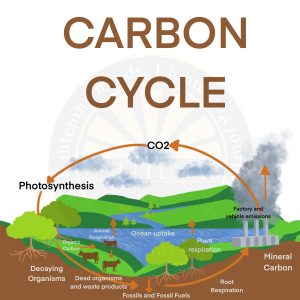What is it?
- The carbon cycle is an important biogeochemical cycle that involves the continuous movement and exchange of carbon in various forms among the atmosphere, terrestrial ecosystems, ocean and Earth’s geosphere (rock and soil).
- The carbon cycle involves the circulation of carbon in various forms, primarily carbon dioxide (CO2) and methane(CH4).
Process Involved
- Photosynthesis: Carbon enters in the form of carbon dioxide into the living world by the process of photosynthesis.
- Respiration: Respiration plays a crucial role in the carbon cycle by facilitating the exchange of carbon between living organisms and the atmosphere.
- Exchange: It tells us about the interaction between the water and the carbon cycle.
- Sedimentation: When animals or plants die, they undergo decomposition, and their remnants transform into sediment, capturing the carbon they once contained.
- Extraction: Anthropogenic activities involve the extraction of fossil fuels from the ground and burn them for energy.
- Combustion: Combustion occurs when any organic material is burned in the presence of oxygen to give off the products of carbon dioxide like heat, light etc.


